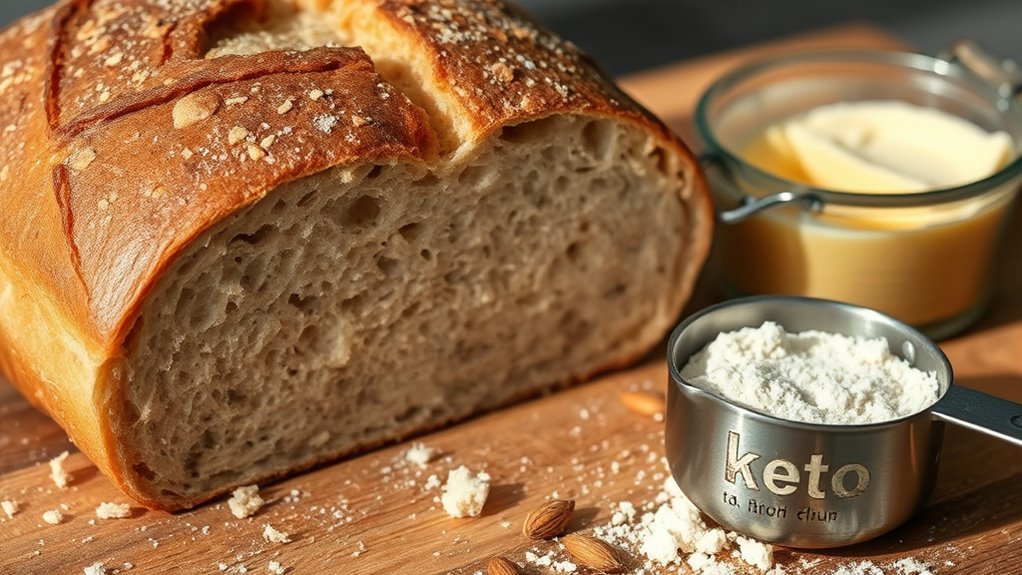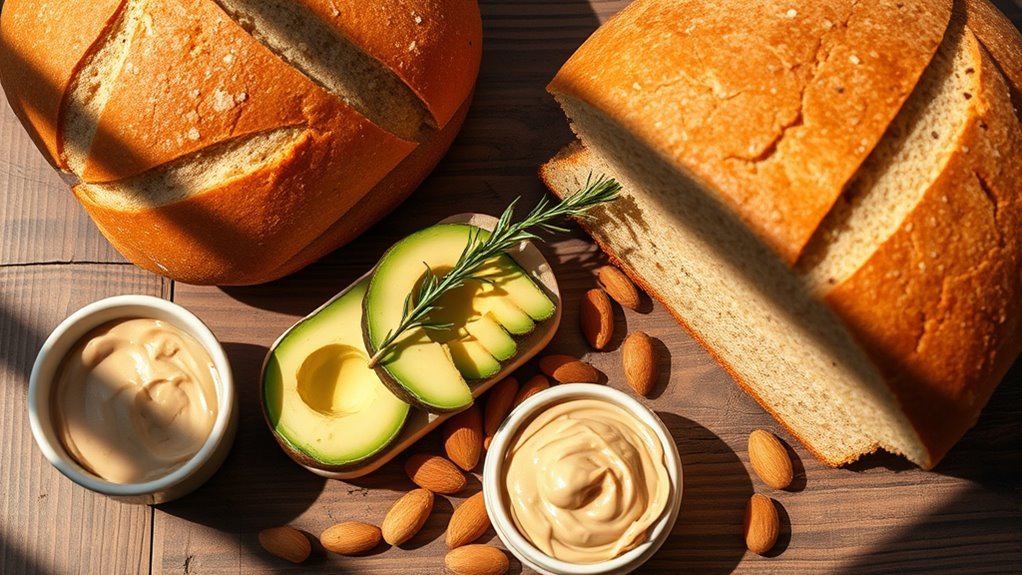Wheat bread isn’t considered keto-friendly due to its high carbohydrate content, which can make it tough to maintain ketosis. Each slice typically has 12-15 grams of carbs, potentially causing blood sugar spikes. While it’s nutritious, offering fiber and essential vitamins, the carbs hinder your keto goals. Low-carb alternatives exist that can satisfy cravings without derailing your diet. If you’re interested in options that fit better within a ketogenic lifestyle, you might want to explore further.
Understanding the Ketogenic Diet

When you consider adopting a ketogenic diet, it’s essential to understand its core principles. At its heart, the ketogenic diet focuses on drastically reducing carbohydrate intake while increasing fats. This shift encourages your body to enter a metabolic state known as ketosis, where it burns fat for energy instead of carbs. While this can promote weight loss and improve mental clarity, it also comes with dietary restrictions that you need to navigate. You’ll need to limit foods like grains, sugars, and certain fruits, which can feel restrictive at first. However, the freedom to explore high-fat, low-carb options can lead to satisfying meals and a healthier lifestyle. Embracing these ketogenic principles can empower you to achieve your health goals. Additionally, understanding the metabolic state of ketosis is crucial for effective fat burning and energy efficiency.
Nutritional Breakdown of Wheat Bread

Wheat bread, often regarded as a staple in many diets, contains a mix of essential nutrients and carbohydrates. Understanding its nutritional breakdown can help you make informed choices. Here are three key aspects to evaluate:
- Fiber Content: Wheat bread typically has a higher fiber content compared to white bread, promoting digestive health and satiety.
- Glycemic Index: It generally has a moderate glycemic index, which means it can cause a gradual rise in blood sugar levels, but it’s still higher than many keto-friendly options.
- Vitamins and Minerals: Wheat bread is a source of B vitamins, iron, and magnesium, contributing to overall health.
While it offers several benefits, keep in mind its carbohydrate content may affect your keto goals. Always assess your personal dietary needs.
Comparing Wheat Bread to Low-Carb Alternatives

While wheat bread has certain nutritional benefits, those following a keto diet might find it challenging to fit into their meal plans due to its higher carbohydrate content. Whole grain options, though healthier than white bread, still contain around 12-15 grams of carbs per slice. In contrast, low-carb alternatives, such as almond flour or coconut flour bread, can contain just 1-3 grams of carbs per slice, making them more suitable for your keto lifestyle. These options not only help you maintain ketosis but also offer a variety of flavors and textures. If you’re looking to enjoy bread while staying low carb, exploring these alternatives can provide you with the freedom to indulge without compromising your dietary goals. Additionally, being mindful of your carb intake is essential for maintaining ketosis.
Potential Health Benefits and Drawbacks
Although many people enjoy wheat bread for its taste and texture, it’s important to reflect on both its health benefits and drawbacks, especially if you’re on a keto diet. Here are some key points to take into account:
- Fiber Content: Wheat bread can be a good source of dietary fiber, which aids digestion and promotes satiety.
- Blood Sugar: Consuming wheat bread may lead to spikes in blood sugar levels, which can be concerning on a low-carb diet.
- Nutritional Value: While it contains essential nutrients, the carbohydrate content can hinder ketosis, affecting your energy levels and weight loss goals. Additionally, many low-carb dieters opt for low-carb alternatives to maintain their dietary objectives without sacrificing flavor.
Understanding these factors can help you make more informed decisions about including wheat bread in your diet, while staying true to your health objectives.
Making Informed Choices for a Keto Lifestyle
How can you navigate the complexities of a keto lifestyle when it comes to food choices? The key lies in effective keto meal planning and careful carbohydrate counting. Start by familiarizing yourself with low-carb alternatives that satisfy your cravings without derailing your progress. Whole foods like leafy greens, nuts, and healthy fats can keep your meals diverse and enjoyable. Consider using apps or tracking tools to accurately monitor your carbohydrate intake, ensuring you stay within your daily limits. Don’t shy away from experimenting with recipes that embrace these principles while still feeling indulgent. Remember, the goal isn’t just restriction—it’s about choosing foods that empower you, allowing you to thrive on your keto journey while enjoying the freedom of a varied diet. Additionally, incorporating lower glycemic index foods can help stabilize blood sugar levels while maintaining your carb limits.
Frequently Asked Questions
Can I Eat Wheat Bread During Intermittent Fasting?
During intermittent fasting, it’s best to avoid eating wheat bread. When you’re fasting, the goal is to give your body a break from food, allowing it to enter a state of repair and fat-burning. Wheat bread contains carbohydrates, which can disrupt this process. If you’re looking for freedom in your eating habits, consider nutrient-dense, low-carb options during your eating window to stay aligned with your intermittent fasting goals.
Does Whole Grain Wheat Bread Have Fewer Carbs Than White Bread?
Whole grain wheat bread generally has a similar or slightly lower carb count compared to white bread, but it’s important to check labels for specific products. In a carb comparison, whole grain often contains more fiber, which can aid digestion and help you feel full longer. If you’re looking for bread alternatives, consider options like almond flour or coconut flour bread, as they can fit better into a low-carb lifestyle while offering more nutritional benefits.
What Brands Offer Low-Carb Wheat Bread Options?
If you’re looking for low-carb wheat bread options, brands like Dave’s Killer Bread, Oroweat, and Franz offer great alternatives. You might be surprised to find that some of these products have fewer carbs than traditional bread. When you compare brands, focus on those labeled as low-carb or high-fiber, as they often provide the best balance without sacrificing taste. Enjoy your freedom to choose healthier bread options while still savoring your favorites!
Can I Make Keto-Friendly Bread at Home?
Yes, you can definitely make keto-friendly bread at home! There are plenty of keto bread recipes that utilize low carb ingredients like almond flour, coconut flour, and eggs. These alternatives help you create delicious bread without the carbs found in traditional recipes. You’ll find that experimenting with different flavors and textures can be fun and rewarding. Plus, it gives you the freedom to control what goes into your food!
How Does Wheat Bread Affect Ketosis Levels?
Wheat bread can greatly affect your ketosis levels. It’s typically higher in carbs compared to keto-friendly options, which can disrupt your body’s ability to stay in ketosis. Eating it may lead to increased insulin production, pushing your body out of fat-burning mode. If you’re aiming for a strict ketogenic diet, you might want to limit or avoid wheat bread to maintain those desired ketosis levels and enjoy the freedom of staying in fat-burning mode.


